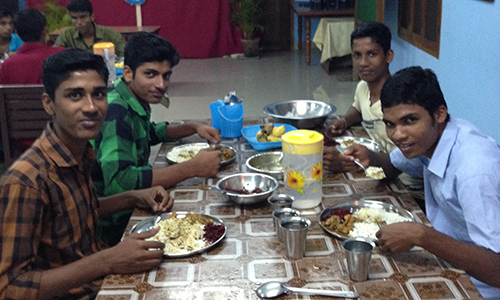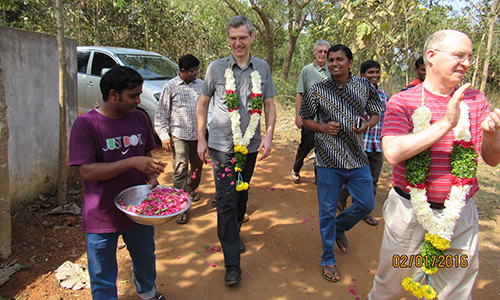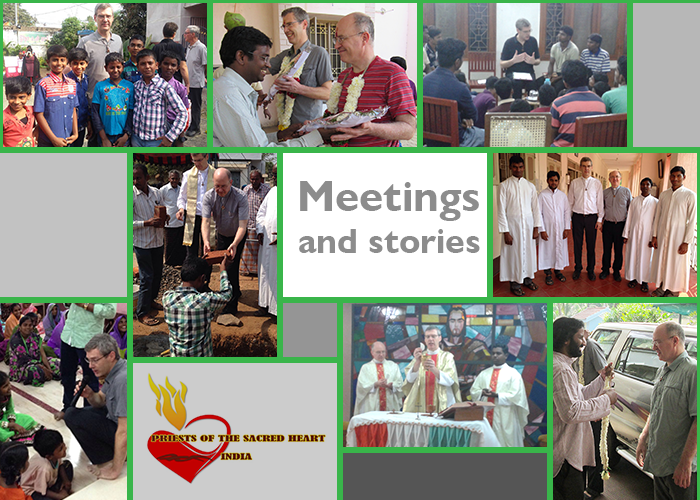
![]() After several days of formation house visits, we experienced some of the SCJ parishes in India. In Kerala, we serve the areas of Koodal and Sooranad. Koodal has perhaps a hundred families, many lowly paid rubber plantation workers. Sooranad is building a new church for its 160 families, raising money locally and doing appeals in larger parishes within the diocese. Many people there work as day laborers, not knowing each day if they will be chosen for work or not.
After several days of formation house visits, we experienced some of the SCJ parishes in India. In Kerala, we serve the areas of Koodal and Sooranad. Koodal has perhaps a hundred families, many lowly paid rubber plantation workers. Sooranad is building a new church for its 160 families, raising money locally and doing appeals in larger parishes within the diocese. Many people there work as day laborers, not knowing each day if they will be chosen for work or not.
The parish priests have seen growing attendance and participation by following the advice of Fr. Dehon – “Go to the people.” They visit homes and try to respond to the needs of the communities in many different ways. One of our SCJ brothers has trained in social work in order to help families through their struggles.
We spent 9 hours on the road, where I got a feel for the population density in India. We drove through seemingly endless urban stretches, with motorcycles and busses, bicycles and pedestrians weaving in and out of the highway, horns constantly honking. I gazed out the window, taking in the sights and sound and smells. It felt like being inside a movie, trying to grasp the plot and meaning of it all. What are the stories the voices of these people would tell?
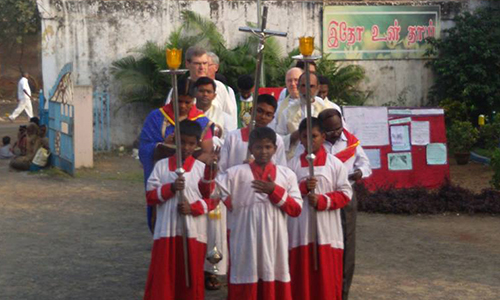
Mumbai is a huge, sprawling, world class megalopolis of 25 million! Spectacular and artistic modern buildings rise in close proximity to vast tracks of sprawling slums. Construction is everywhere as the government tries to implement its long term strategic improvement plans.
We met with auxiliary Bishop Savio, , who welcomed us with tea and biscuits. As the Indian district grows, the SCJs are looking to expand into new areas and are in dialogue about what kinds of ministry which flow from our Charism of Love and Reparation would serve the needs of the diocese.
When traveling a a little sight-seeing is always good for the spirit. The hundred year old Gate of India was built to greet ships arriving in the harbor area. The last British troops symbolically departed from the same spot in 1948 after India achieved independence. Across the road was the magnificent hotel that was the tragic site of a terrorist attack just a few years ago.
The church rectory in Vasai only has one guest room, so Fr. Heiner and I experienced the hospitality of one of the parish families. I appreciate talking about culture, history, politics from local folks. We heard stories about family members pictured on the walls around us and got a sense of daily life for people in this part of the world.
Mass in Divine Mercy parish was in English, so Fr. Heiner presided and I was invited to preach. St. Paul’s exhortation about love being patient and kind fits in so well with both SCJ spirituality and our struggles to daily live a Christian life. Dancers led the entrance procession, and the youth choir sang out in lovely harmonies.
After mass 16 members that make up the parish council sat in a circle and after sharing a snack, began to tell us how they see the needs of the church in this area. Though a small parish, people are committed to building up the community with many groups and activities. Though the dreams of a new church seem far beyond their means, they are making small sacrifices and slowly building towards the day that can become a reality.
In the evening we took a drive to the substation, St. Anthony, a tiny worship space on the 2nd floor of a building that looked much like all the concrete homes on the block. We climbed a narrow concrete stairway to reach the upper room. While so different from the grandeur of historic Roman churches, I’ve been visiting, this more clearly called to mind the basics of our faith. This more surely resembled the upper room where Jesus ate with his disciples. On a hot day we were greeted with a glass of cool water, and I thought of the gospel and prayed God would bless them for the hospitality given in Jesus’ name.
An 11th standard (grade) student we met at church was one of the few who knew English, and acted as spokesperson for the community. She wanted us to honor her family with a visit to their home, so we followed. Surrounding the mission were poor and simple cinder block homes, with sewage trickling along a small channel in the concrete. Children’s laughter came from the makeshift cricket filed cleared amid piles of garbage.
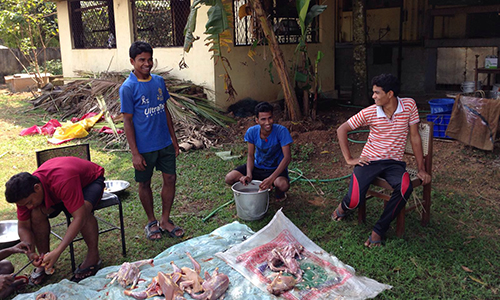
We entered a home for the family of 5. It was tiny, perhaps 12 by 30 feet. The home was decorated with brightly colored holy pictures on the walls. Half the space was living room, with the couch doubling as a bedroom. The other half was kitchen, where the mother also cooked food to sell in the neighborhood. A small loft was tucked near the peak of the sloping tin roof where the children slept. With so little space to start with, the family’s only transportation, a motorcycle was also inside for safe keeping.
On the way home we drove through a crowded brothel district, with women lined along brick alleyways, trying to attract enough customers to earn their daily bread. Apparently the government does license sex workers, yet life is still harsh and AIDS is a constant danger. A group of Religious Sisters has a center in the area to reach out to those caught in the web, and to care for younger girls and try to keep them from falling into such a life.
We flew to the state of Andra Pradesh, When we arrived in Eluru all the students were waiting at the gate, with an entourage of drums to lead us to the entrance of our Theology House. After working many years in South Dakota I recalled the importance of drums and also discovered a similar role in Indian culture here.
The statue of Jesus sits cross legged in guru position, and in chapel for prayer we take off our shoes as well. Here we have 26 theologians and 3 formators to work with them. After mass and supper the students put on a program with music, dance prayer and presentation. The students had a guitar and asked me to play a song. When I adapted the lyrics of “I’m Gonna Be Somebody” to tell of a longhaired Eluru boy, they let out whoop. Three of the community members shared a February 2 birthday, so they were feted as well. They have a tradition of feeding each other a piece of the birthday cake, much as you would see at a wedding in the States.
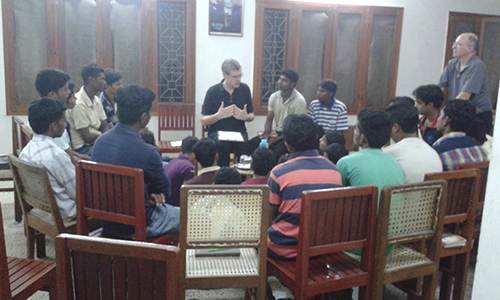
At 5:30 the next morning, bells rang to rouse everyone, and one of the priests set a bucket of hot water from the kitchen outside my door. I am spoiled with a hot shower to get me going in the morning, but here I am getting good at sponge baths. Another sign of difference was looking out my window and seeing a monkey scurry up the tree.
With only two days and more than 30 people to interview, we had a packed schedule. We could only give the students about 15 minutes each, but they came prepared and enthusiastically shared their hopes and honestly shared their difficulties. They are proud that the district is young and enthusiastic, yet often feel, as one student told us, “like a young bird that has not yet learned to spread its wings and fly.” I hope I can be supportive as they find their way.
Formation is a difficult ministry. You don’t get the same kind of affirmation as in a parish, so I am grateful for those who are dedicated to this needed service in our congregation. Students in formation go through a healthy independence and rebellion stage that is good but painful on both sides. Theologians wrestle with all kinds of questions about God, religious life, and how we are called to live. Our actions don’t live up to our ideals, and students challenge formators.
One student spoke of there can be two different ways to feel you have disappointed your elders, depending on your relationship with them. Some people you obey out of fear of punishment or consequences. With an inspiring leader you fear disappointing them because you want to make them proud. The latter is the kind of leadership all of us aspire to live.
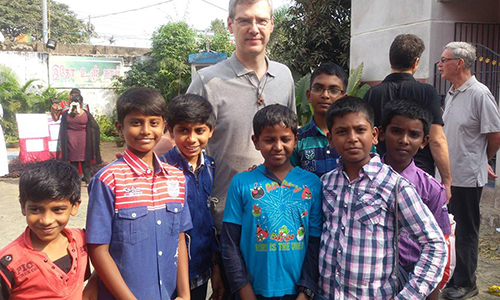
We visited the parish of Vembadu and its 3 substations. We were greeted at the main parish by a trio of girls in traditional attire dancing a welcome and leading us into church. Colorful and bright decorations lit up the inside as we learned of the parish activities. Through pastoral visits and consistent attention the Catholic community is growing. We even have a couple of candidates from the village. I have been impressed by the parish work I see so far.
Afterwards we walked down a cow path, children holding our hands and guiding us in the darkness to help us avoid cow patties. At the edge of a rice paddy we dedicated a cornerstone. I even tried my hand at spreading mortar on the bricks will eventually become a safe and fitting for the women of the village to work and develop various cottage industries.
Our novitiate is the Sacred Heart Ashram in Nambur. The covered walkway connecting a circle of buildings reminds me of my novitiate in Victorville California. One significant difference is that here they raise much of their own food, including rabbits and pigs. We have 6 novices and 7 postulants preparing for their entrance into religious life.
In their skit they showed powerful, depicting a suicde the consequence of bullying and harassment.
We hit the road again and undertook a long hot and dusty journey to us to the parish in Nolganda, But the time passed profitably, with Frs Anil and Baja Raju telling us about the land and culture and history along the way. Two of our priests are stationed at Our Lady of Fatima, They rent a 2 room flat from a Hindu family who is good to them, but doesn’t want Christian religious activity on the property, which limits the pastoral activity they could do from a traditional rectory. Plans are under way to eventually build a community house, and an orphanage to take care of needy children in the area.
The parish is quite simple, mostly made up of field workers and their families. In this part of the state of Andra Pradesh we passed many fields of chili, cotton and rice paddies, although with drought the rice harvest has been reduced from twice to once a year, putting already poor families at the edge. The government has tried to supply some work to supplement income, but the added pay is also very meager. Some of the workers live under canvas lean-tos.
The novitiate looks like it is out in the country, but the area is rapidly developing. India divided the Andra Pradesh state into two states, and the new capital is expanding. We were told that over the next few years something like 80,000 government jobs will be created. High rises are starting to replace two and three story cinder block homes.
A mile from the novitiate is a university with 7000 students, and modern classroom buildings. We saw some students playing Kabadi on sandy courts, a game like tag but with tackling and full contact that is a national favorite. Engineering and Computer are huge fields here.
With the help of US benefactors, the SCJs have built a vibrant, colorful parish. Our reception included acrobats and tight rope walkers, and a woman who could lift a 5 gallon metal bucket of water with her teeth. We had dancers, flower wreaths and even some fireworks, which drew the wrath of a neighbor worried that his thatch roof might catch on fire. Inside parishioners presented accounts of their activities, including active youth groups, neighborhood outreach and scholarships that allow girls who might otherwise be married very young to stay in school.
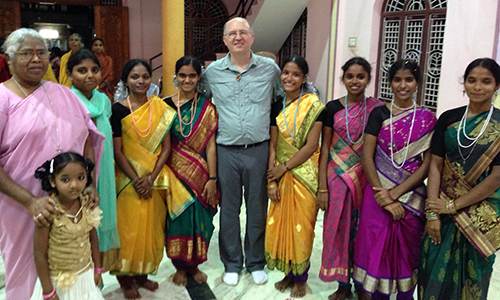
We uncounted a new wrinkle to the welcoming ceremony when we arrived at the minor seminary in Gorantla. Besides the flower wreathes and sandalwood paste, they washed our feet in memory of what Jesus did. It was very fitting on a day where 4 priests and 2 deacons were ordained in an outdoor ceremony on the grounds.
First though we visited a two room schoolhouse for 60 neighborhood children that doubles as a chapel on Sunday. And we met with the bishop of Guntur, Gali Bali, who stayed with us in Rome not long ago. He greeted us as old friends.
The ordination was a joyful celebration, 3 hours long with song and dance, and a drum procession. Most of the mass, including the homily was in local language. Since I could not understand the words, I paid more attention to the ritual, which made it more reflective. I like that about our Catholic practice.


